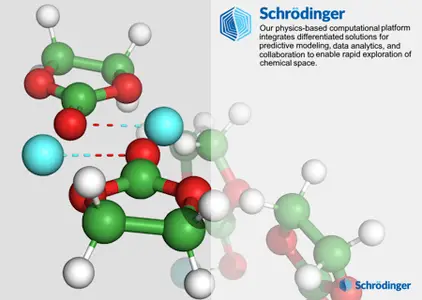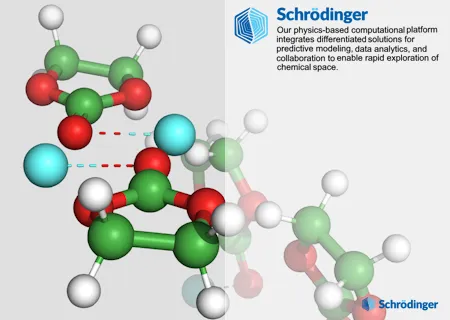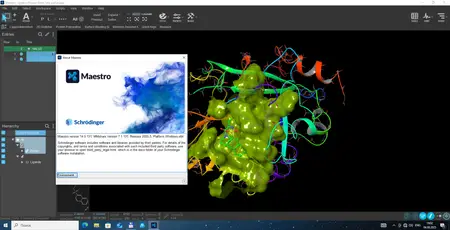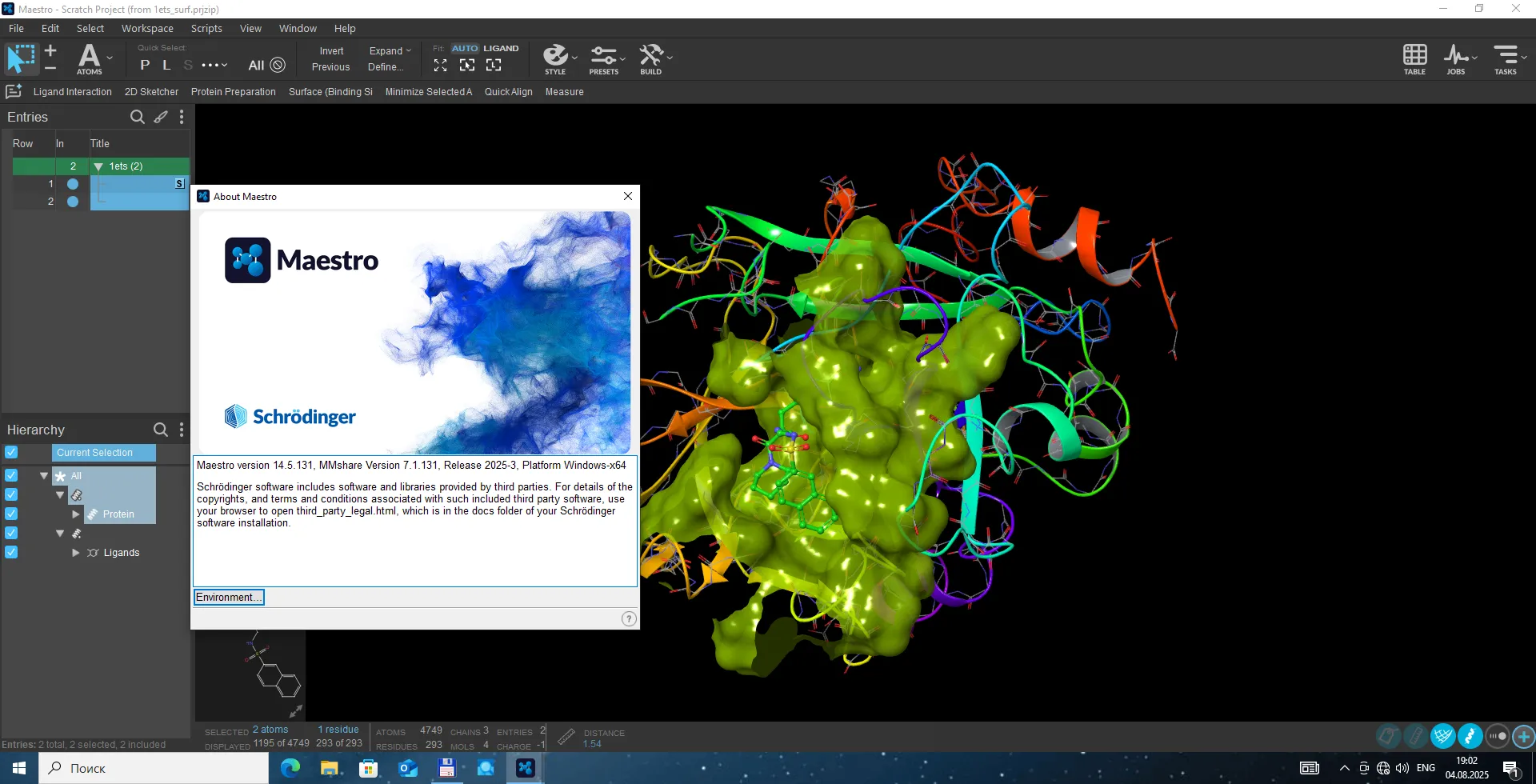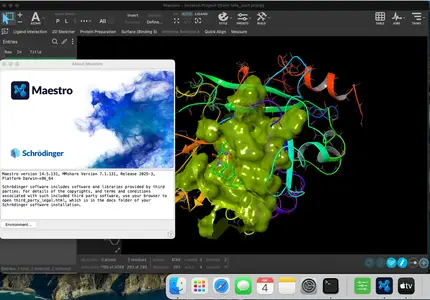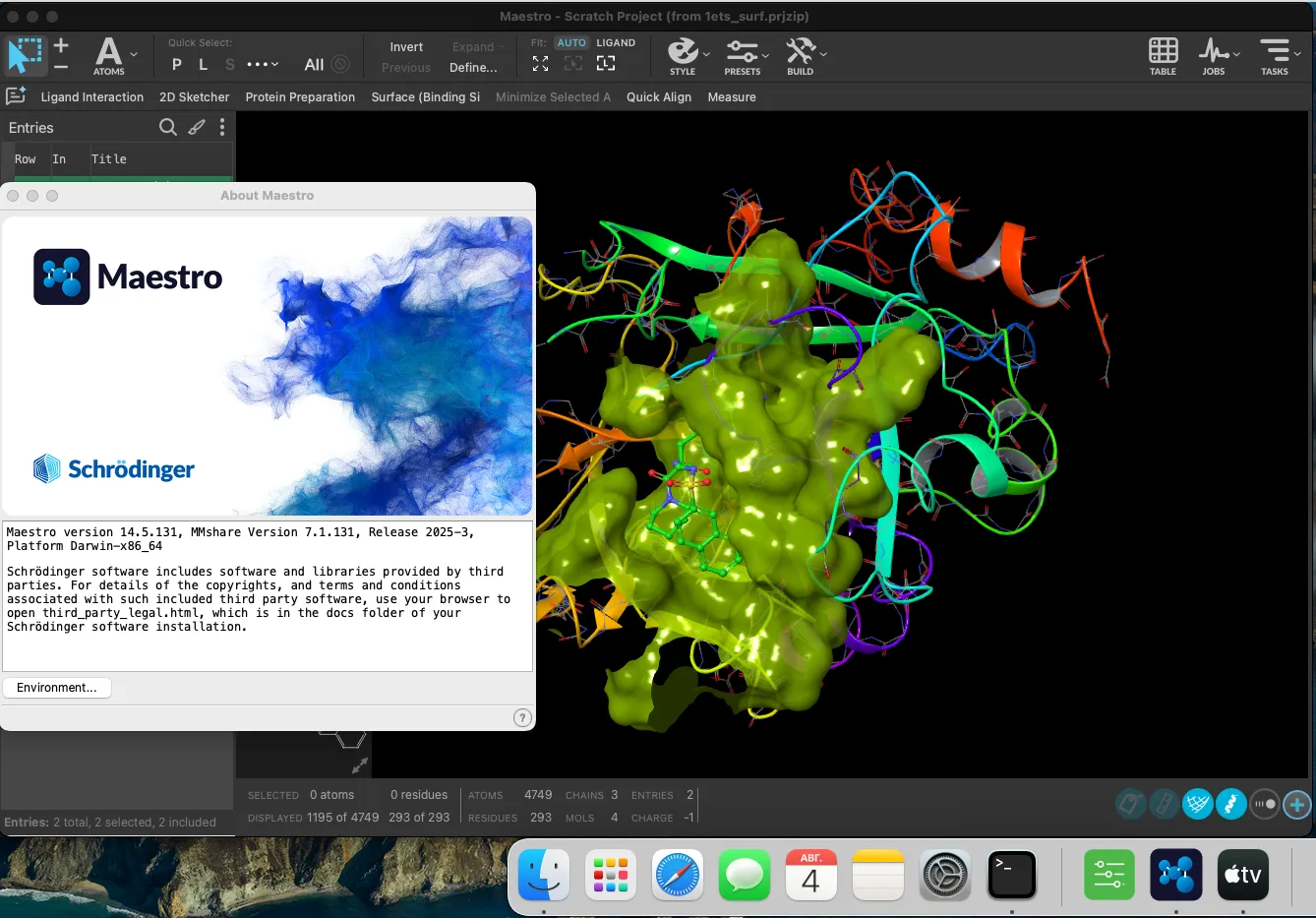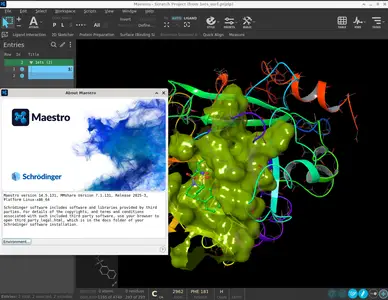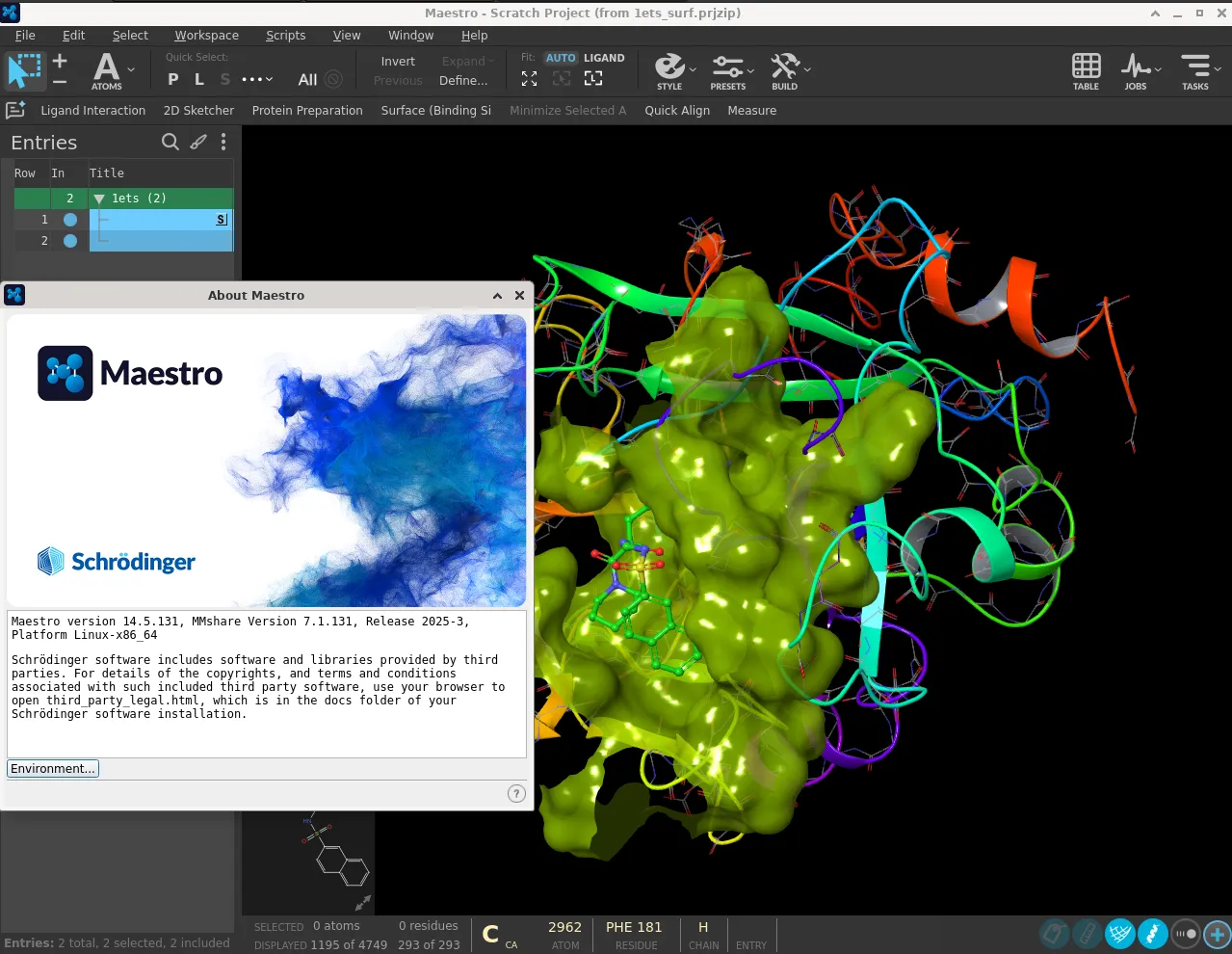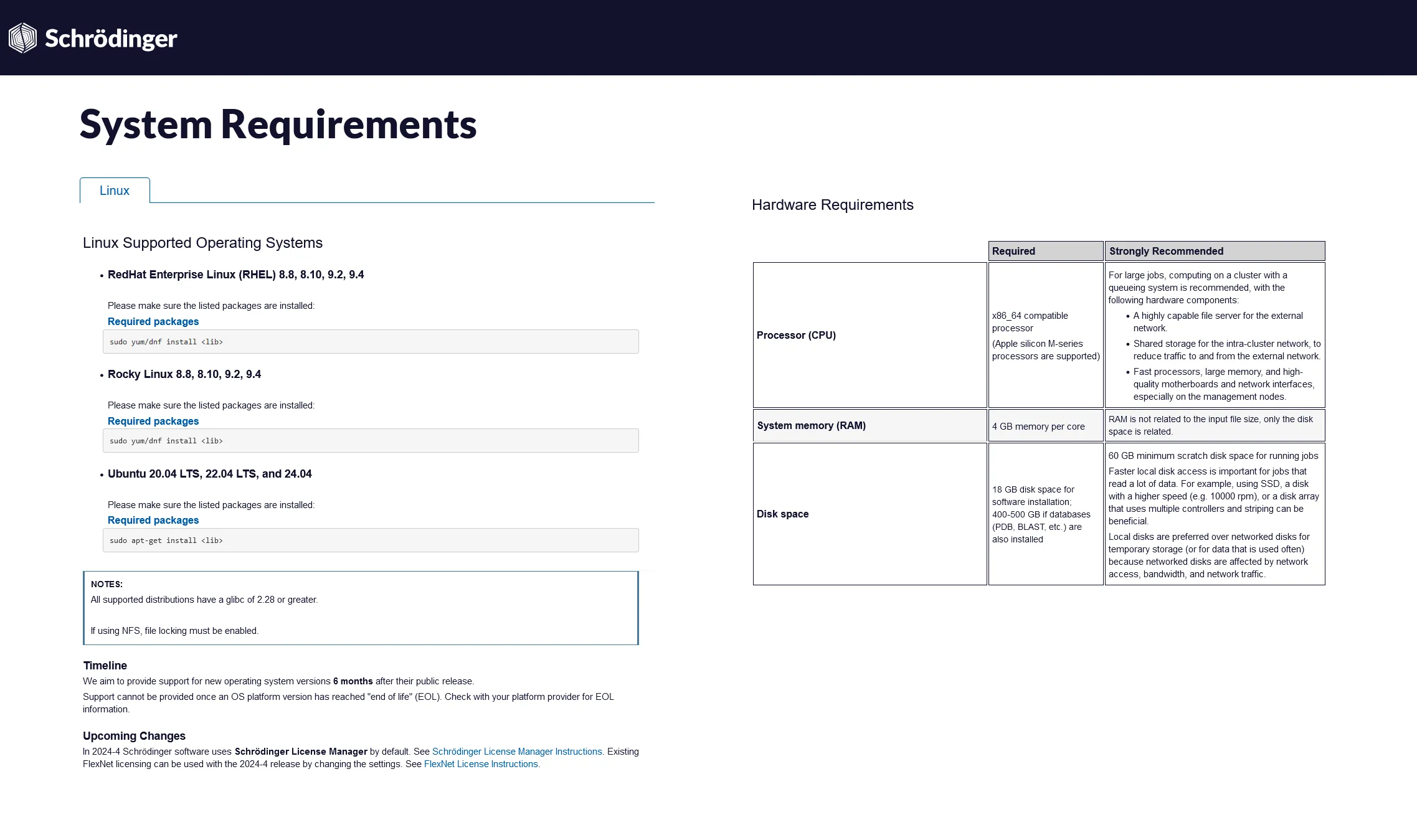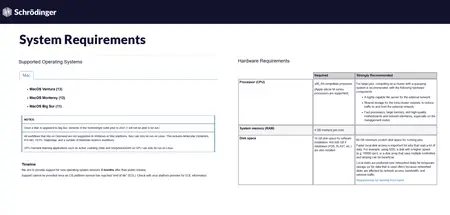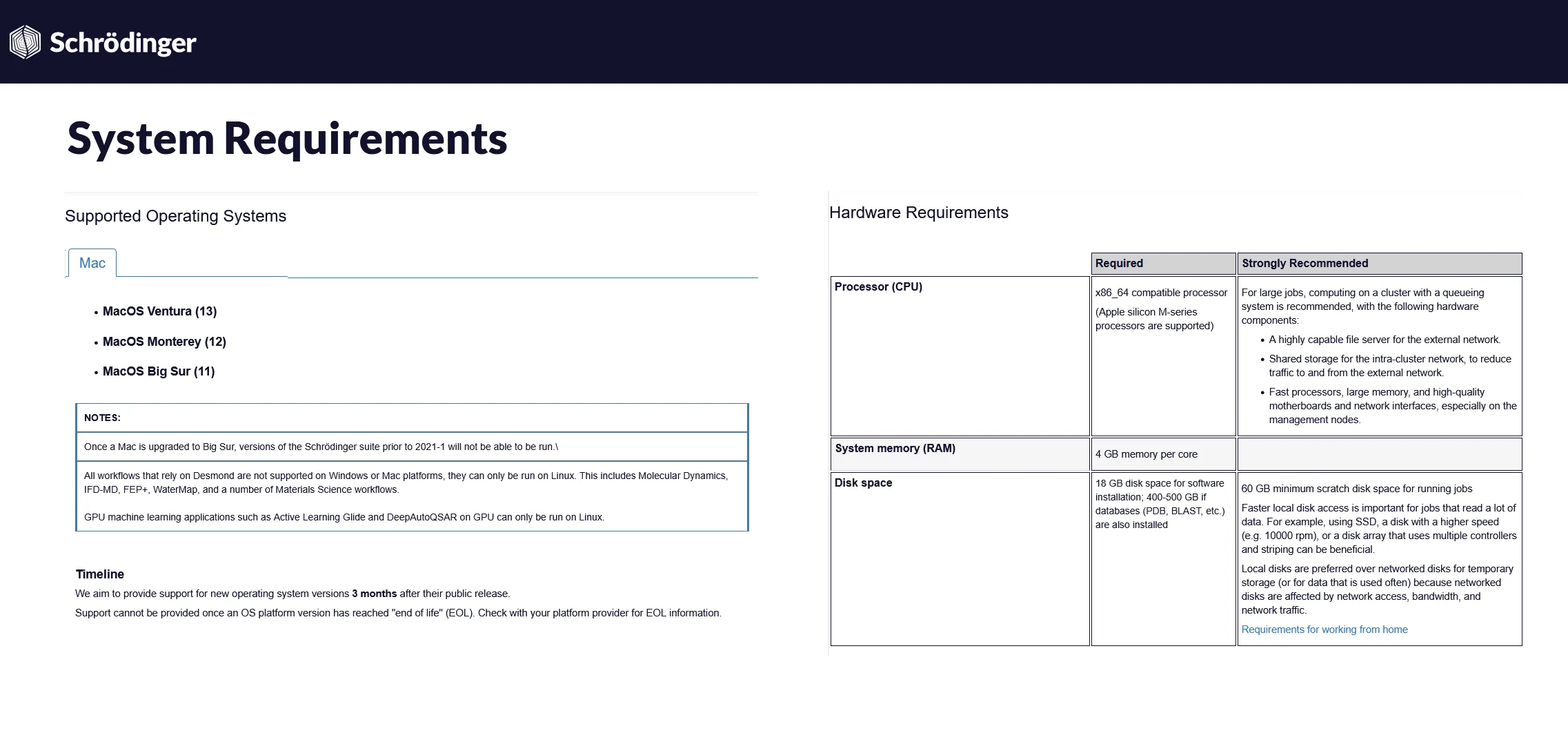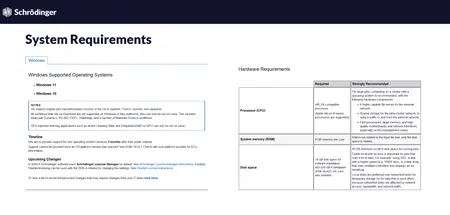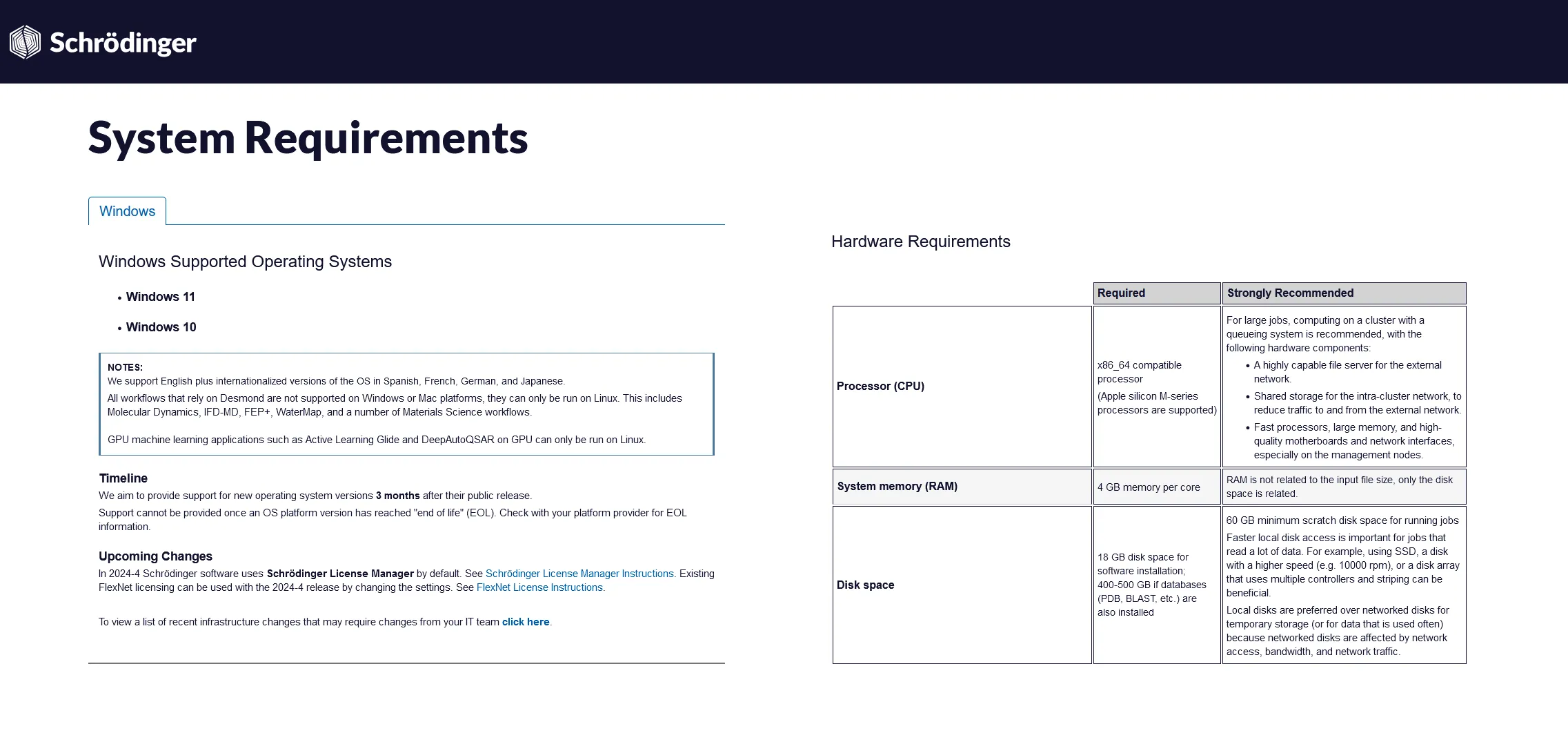Schrodinger Suites 2025-3 | 35.3 Gb
The software developer Schrödinger continuously strive to develop scientific solutions that push the boundaries of molecular design and are delighted to share enhanced drug discovery and materials workflows in Schrödinger’s 2025-3 software release.
Small Molecule Drug Discovery
Platform Environment
Maestro Graphical Interface
- Hovering the cursor over an atom in the Workspace now simultaneously highlights its corresponding row in the Project Table and displays its row number in the Status Bar
- Improved defaults to “Get PDB Dialog” to auto display 2Fo-Fc diffraction data and auto set isocontours in EM maps to the Author recommendation
- Redesigned 2D Viewer Export with dedicated options dialog to control image size and support for high-quality SVG format for both single structures and HTML grids
- New Maestro Assistant (beta) – An AI-powered conversational interface providing context-aware help via the Schrödinger Knowledge Bot and enabling natural language styling command execution within the 3D workspace
Force Field
- Updated FFBuilder default reference method to the MPNICE potential
. Roughly 5x faster for typical chemistries
. 20x faster for boron, bromine, iodine and silicon containing compounds
Target Validation & Structure Enablement
Protein Preparation
- Protein Preparation Wizard interactive jobs now save temporary files under a named folder in the Maestro working directory
Protein X-Ray Refinement
- Improved defaults to “Get PDB Dialog” to auto display 2Fo-Fc diffraction data and auto set isocontours in EM maps to the Author recommendation
- Redesigned GlideMap panel to dock ligands into maps generated from X-ray data by GlideXtal
Cryo-EM Model Refinement
- Redesigned GlideMap panel replaces the GlideEM panel with more granular options for fitting small molecule ligands into cryo-EM density maps
IFD-MD
- New Template Ligand Finder for ligand-binding mode prediction and cryptic binding site identification (Beta): Rapidly identify and visualize homologous proteins based on both protein and ligand similarity to uncover potential template ligands as references for IFD-MD
Binding Site & Structure Analysis
Mixed Solvent MD (MxMD)
Enhanced cryptic binding site identification with updated in silico workflow (Beta): New workflow combining mixed solvent molecular dynamics (MxMD) with SiteMap to reliably reveal and detect cryptic binding sites
Hit Identification & Virtual Screening
Docking
- Optimized Glide which is nearly 2x faster than Glide is now the default method
- Revamp of the Glide WS MMGBSA correction
Ligand Preparation
Macrocycles
- Add command-line options to restrain cis/trans isomerism during alignment with tug_align.py
- Add a command-line option to tug_align.py to control MCS search algorithm timeout
- Small performance improvements to PrimeMCS
ABFEP
- Automatic membrane placement for AB-FEP simulations
Lead Optimization
FEP+
- New Settings interface that replaces the Advanced Options interface for more intuitive and easy simulation set up
- Clear predictions for RB-FEP edges
- Similarity Score column displayed in the analysis tab
- Batch delete and download multiple jobs with enhanced usability of the ‘Web Services Jobs Table’ panel
- Extend Atom Mapping to matched R-groups
Constant pH Simulations
- Improved panel usability and layout
- Added support to run constant pH simulations via Web Services
FEP Protocol Builder
- Roughly 2X speedup in workflow through improved defaults
- Improved accuracy in generated FEP+ maps through exploration and scoring of submaps with Louvian clustering. Alternatively, users can input desired submaps
- New cost-optimal option using Pareto Selection of FEP-PB Models to generate the best value protocols
- Improved prediction accuracy of generated maps through FEP+ Groups support, where ligands with different protonation, tautomeric, and conformational forms will be grouped, enabling FEP Group corrections to be applied
Quantum Mechanics
- Predict Ames toxicity via a QM-based workflow following Leach et al. (2009)
- X-ray emission spectroscopy (XES) prediction is now available (command line only)
- Implemented nine new double hybrid functionals with RI-MP2: B2-PLYP, B2GP-PLYP, DSD-BLYP, DSD-PBEP86, PWPB95, B2K-PLYP, B2T-PLYP, DSD-PBEB95, MPW2-PLYP
- Wave function stability analysis automatically corrects SCF instabilities leading to a more stable wave function
- Predict Nucleus-Independent Chemical Shifts (NICS) with new workflow
- Optical rotation as a function of wavelength
- Employ MLFFs (machine learning force fields) by setting Level of Theory option
- MPNICE now supported in all Jaguar workflows that have supported use of QRNN
Biologics Drug Discovery
- Easily specify mutational variants to be modeled in MMGBSA Residue Scanning by uploading an input FASTA file
- Load, analyze and visualize in the MSV desired mutations specified in the MMGBSA Residue Scanning Panel by newly available export of variants to a FASTA file
- Macromolecular Pose Filtering supports multi-chain ligands when filtering based on data obtained from Hydrogen-Deuterium Exchange (HDX) experiments
- Added a predefined selection for the Vα-Vβ interface, located under the TCR Regions menu, to enable one-click selection of this key binding region
- New T cell receptor (TCR)-specific presets
Materials Science
GUI for Quantum ESPRESSO
Product: Quantum ESPRESSO (QE) Interface
- Defect Correction: (+DEFECT_FORMATION_ENERGY) Formation energy computed in the panel
- Finite displacement method for phonons (command line)
- Increased number of iterations and cycles for default setup
- Support for GBRV pseudopotentials by default
MS Surface
Product: MS SurfChem
- Desorption Enumeration: (+ASSOCIATIVE_DESORPTION) Option for associative desorption
Microkinetics
Product: MS Microkinetics
- Calculation of selectivity from Catalytic Reaction Analysis (command line)
Reactivity
Product: MS Reactivity
- Reaction Network Profiler: Support for Garza solvation entropy partition functions (command line)
- Nanoreactor: Improvements to elementary reaction network algorithms
KMC Charge Mobility
Product: MS Mobility
- Option to compute field-dependent mobility based on charge diffusion (command line)
Dielectric properties
Product: MS Dielectric
- Complex Permittivity: Option to apply custom fitting parameters
- Complex Permittivity: Display of predictions from multiple fits
- Complex Permittivity: Option to input a pre-equilibrated structure
- Complex Permittivity: Improved speed from KWW parameter calculations
Reactive Interface Simulator
Product: MS RIS
- Solid Electrolyte Interphase: Support for custom reactions that modify bond orders (command line)
- Solid Electrolyte Interphase: Improved algorithm to track unpaired electrons
Crystal Structure Prediction
Product: Crystal Structure Prediction
- Crystal Structure Prediction: Simplified UI for improved UX
- Crystal Structure Prediction: All space groups shown in Advanced Settings
Advanced Force Field Applications
Product: MS FF Applications
- Machine learning force field support in QM and MD panels
Transport Calculations via MD simulations
Product: MS Transport
- Diffusion: Support for GPU calculations on driver host
- Ionic Conductivity: (+IONIC_CONDUCTIVITY) Workflow solution to predict ionic conductivity in liquids
- Thin Plane Shear: (+PLANE_SHEAR_VELOCITY_PROFILE) Reduced noise in velocity profile
- Thin Plane Shear: (+PLANE_SHEAR_VELOCITY_PROFILE) Direct calculation of viscosity velocity profile
- Thin Plane Shear: Improved control of shear area to avoid drift of slabs
Coarse-Grained (CG) Molecular Dynamics
Product: MS CG
- Speed up for assignment of the coarse-grained force fields for large systems
- Coarse-grained Mapping: GUI panel for automatic mapping of CG structures
- CG FF Builder: Automated addition of antifreeze water for MARTINI mapping
- CG FF Builder: (+CGFF_BUILDER_MARTINI_NPT) Support for NPT ensemble during the fitting of MARTINI force field parameters
- CG FF Builder: Support for encrypted force field parameters
- CG FF Builder: Support for loading output from CG Mapping as input
Materials Informatics
Product: MS Informatics
- Machine Learning Property: Tooltip to visualize the training set chemical space
- MD Descriptors: Automated setup for label and number of components from input CSV
Formulation ML
Product: MS Formulation ML
- Support for the description of ingredients without SMILES strings
- Formulation ML: Visualization of model performance from the GUI
- Formulation ML: Option to export feature importance to CSV
- Formulation ML: Option to compute feature importance during training
- ML Model Manager: GUI for management of model and version information
Layered Device ML
Product: MS Layered Device ML
- OLED Device ML: Support for classification models
MS Maestro Builders and Tools
- Adsorption Enumeration: Improved adsorption for sterically hindered atoms
- Adsorption Enumeration: De-duplication for molecular adsorption
- Complex Builder: Title suggestions for sketched ligands based on IUPAC name
- Complex Builder: Build dimeric organometallic complexes
- Disordered System: Speed-up for snap-to-grid and amorphous modes
- Disordered System: Support for MLFF
- Meta Workflows: Support for MLFF
- Polymer: Setup for angles on coarse-grained polymer models
Classical Mechanics
- Complex Bilayer: (+COMPLEX_BILAYER_BUILDER) Model building solution for complex protein membrane systems
- Diffusion: Support for MLFF
- Polymer Crosslink: Speed up with improved crosslinking algorithms
- Electrolyte Analysis: Option to plot density distribution isosurface
- MD Multistage: Preset relaxation protocol for stiff polymers
- MD Multistage: Preset relaxation protocol to aid convergence in OPLS5
- MD Multistage: Option to choose electric field units
- MD Multistage: Option to view steps from the preset relaxation protocols
- MD Multistage: Support for MLFF
- Molecular Deposition: Support for MLFF
- Polymer Chain Analysis: Improved speed on searching for backbone atoms
- Prepare for MD: Support for MLFF
- Radial Distribution Function panel restored for user access
- Visualize Restraints: Tool to show restraints in systems for MD simulations
Quantum Mechanics
- Adsorption Energy: Support for MLFF
- Beta Elimination: Support for MLFF
- Bond and Ligand Dissociation: Molecular formulas printed for fragments
- Nanoreactor: Support for MLFF
- Optoelectronic Film Properties: Option to calculate the reorganization energies for ISC/RISC
- Optoelectronic Film Properties: Option to plot the distribution of singlet-triplet splittings for ISC/RISC in the viewer panel
- Probe Grid Scan: Support for MLFF
- Reaction Energetics Enumeration: Support for MLFF
- Reaction Network Profiler: Support for MLFF
Materials Science
Life Science
- New Tutorial: Preparing Nucleic Acid Structures
- New Tutorial: Structure Visualization and Interaction Analysis in Nucleic Acids
- New Tutorial: Analyzing Binding Sites of Nucleic Acids with SiteMap
- New Tutorial: Small Molecule – Oligonucleotide Docking with Glide
- New Tutorial: Forming RNA – Ligand Interactions with Ligand Designer
- New Tutorial: Potency Predictions for RNA-Binding Small Molecules Using RB-FEP
- New Tutorial: Predicting Drug Residence Times from Unbinding Kinetics Simulations
- New Learning Path: Oligonucleotide Modeling
- Quick Reference Sheet: GlideMap
Materials Science
- New Tutorial: Machine Learning Force Field
- Updated Tutorial: Nanoreactor
- Updated Tutorial: Organometallic Complexes
- Quick Reference Sheet: MLFF Calculations
- Quick Reference Sheet: ML Model Manager
- Quick Reference Sheet: Coarse-Grained Mapping
- Quick Reference Sheet: Visualize Restraints
- Quick Reference Sheet: Welcome Screen
Documentation Content
- Licensing information displayed in panel help documentation
- Materials Science Panel Explorer: Filter for panels that support MLFF
LiveDesign
What’s Upcoming in 2025-3
- Upload 3D files into a Freeform column cell and view the structure in the 3D visualizer: View and run parameterizable models on custom 3D inputs
- Overwrite and append file-uploaded data on Biologics: Track and register entities while sequencing
Schrödinger Software provide accurate, reliable, and high performance computational technology to solve real-world problems in life science research. It can be used to build, edit, run and analyse molecules. The Schrödinger-Suite of applications have a graphical user interface called Maestro. Using the Maestro you can prepare your structure for refinement. The following products are available: CombiClide, ConfGen, Core Hopping, Desmond, Epik, Glide, Glide, Impact, Jaguar ( high-performance ab initio package), Liaison, LigPrep, MacroModel, MCPRO+, Phase, Prime, PrimeX, QikProp, QSite, Semi-Empirical, SiteMap, and Strike.
Schrödinger Release - New Features 2025-3
Schrödinger, LLC provides scientific software solutions and services for life sciences and materials research, as well as academic, government, and non-profit institutions around the world. It offers small-molecule drug discovery, biologics, materials science, and discovery informatics solutions; and PyMOL, a 3D molecular visualization solution. The company was founded in 1990 and is based in Portland, Oregon with operations in the United States, Europe, Japan, and India.
Owner: Schrödinger, LLC
Product Name: Schrödinger Suites
Version: 2025-3 Commercial Version *
Supported Architectures: x64
Website Home Page : www.schrodinger.com
Languages Supported: english
System Requirements: Windows, Linux, macOs **
Size: 35.3 Gb
* Notes: All workflows that rely on Desmond are not supported on Windows or Mac platforms, they can only be run on Linux. This includes Molecular Dynamics, IFD-MD, FEP+, WaterMap, and a number of Materials Science workflows. GPU machine learning applications such as Active Learning Glide and DeepAutoQSAR on GPU can only be run on Linux.
Please visit my blog
Added by 3% of the overall size of the archive of information for the restoration
No mirrors please
Added by 3% of the overall size of the archive of information for the restoration
No mirrors please


